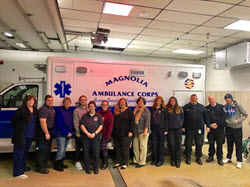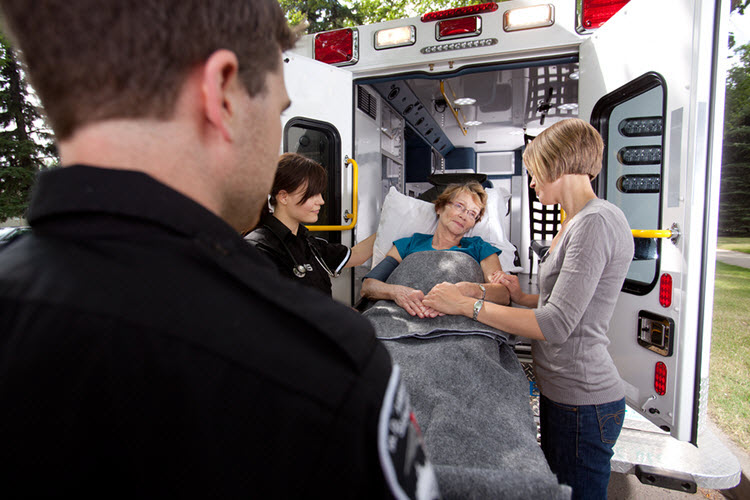How Emergency Medical Technicians Responded.
I recently had the privilege of helping to put first responders from the Magnolia Ambulance Corps through the Virtual Dementia Tour® (VDT®).
The VDT® is a scientifically proven, experiential learning experience that uses patented sensory tools which alter your senses. You are then given instructions to complete common everyday tasks. The physical and mental challenges of those with dementia become heartbreakingly clear. This program comes out of research conducted by PK Beville, M.S. and founder of Second Wind Dreams®. (Jump to Lessons Learned)
Members of the Magnolia Ambulance Corps range in age from sixteen to sixty plus and careers are equally diverse. Regardless of age and how they make a living, these volunteers are bound by a commitment to serve their community. Their commitment includes giving up several hours one evening to “walk in the shoes of someone with dementia.” Even prior to the VDT®, our volunteers took time out for a pre-interview.
Pre-interviews gave me insight into protocols, dementia specific training and each person’s general understanding around the aging process. And it gave me insight into the tremendous responsibility you have as a first responder. Protocols must be followed, you don’t know what you will find when you get on scene and life and death decisions must be made quickly.
Pre-Interview:
On a call, what information are you required to get from the person you are helping?
Arrival on scene requires getting answers to key questions on personal information and medical history. Questions include: name, address, date of birth, phone number, medications, allergies, and your reason for the call to name just a few. If the person can’t answer these questions, they will ask others in the room, or on scene.
Do you receive training on how to approach things differently when the call is with a person living with dementia or a person with disabilities?
In general, EMT first responders in New Jersey receive little dementia specific training. Some information about aging is covered in EMT training and some in online CEU courses. One VDT® participant had a disability certification which allows him to modify his approach to care, but not change the span of care. In addition, New Jersey mandates that you treat a person with disabilities the same as others.
General true and false questions often split by age.
Younger folks were more likely to think most people over age 65 have some form of dementia. Half the respondents knew that the fastest growing segment of our population is age 85 and up. Half knew that the best way to communicate with someone that is elderly is non-verbal (e.g. body language) and almost all knew the best way to communicate with someone with dementia in an emergency is NOT to provide reality checks.
Debrief:
After participating in the VDT®, I spoke with each participant to understand what the experience was like for them, what they learned and what they might do differently going forward.
“This sucked. Going through the exercise was nerve jangling.
It scares me to think of what my family would have to go through if I had dementia.”
How was the experience for you?
Interesting was the word I heard most often, followed by difficult, frustrating and a real eye opener. Many commented they were not used to the deficits, so they worked hard to overcome them.
What was the sensory deprivation like for you?
“The sensory overload made it hard to focus, there was so much going on in my head.”
Aging affects all the senses and dementia adds a level of complexity to these changes. The VDT® experience focuses on vision, hearing, touch and mobility. Everyone came out of the experience with ideas on how they could approach a call with a senior differently. Especially if they suspect dementia from their age, facial expression, attire, balance/gait and actions.
Vision – Despite finding it disorienting, each participant cognitively understood what was going on. They were able to think about how to adjust for vision impairment or alternative ways to approach the task.
- I would approach more slowly, not just pop up in front of them.
- Don’t stand behind them and talk to them, get on my knees to be at their level or move myself to be more in their field of vision.
- We see things clear as day, they do not, so take it step by step and reassure them as we go through the process.
- Instead of making them the sign sheet, make sure they can see it and what it says.
Hearing – Many participants found it annoying, distracting and hard to concentrate on directions and tasks.
- On a call I would take them or bring them to a quiet place. Make sure only one person at a time was talking. Let the person with the lowest voice tone take the lead with the idea that the elder would hear that person better.
- I would talk slower and repeat for understanding. I would not talk louder.
- No more than one person asking questions.
- Make sure things are quiet, don’t use sirens, or have all the lights on in the back during transport.
- Get them to focus on me, get on my knees in front of them if they are sitting.
Mobility – most participants found walking uncomfortable and restrictive in terms of how fast they could move, and felt they were now more aware of mobility issues.
- On scene, as part of situational awareness, I would look for a cane, rollator or wheelchair.
- When you size up scene for safety, look at the environment for trip hazards like low lighting or a dog. Move things out of their way but put it back so as not to confuse them.
- It is safer for people to walk than to carry them. So, I would ask if they want/can walk. If they can’t walk, I would use the stair chair. It is a 50/50 dynamic because dignity comes into play.
- I would give them more time to move and help them walk if they want to walk.
- Move them the least amount of times possible. Limit walking during transport.
- If they are wearing slippers I would ask if they wanted help in putting on shoes and I would offer to get something for them they needed, like medication.
- If they tell me they can’t walk or I think they’re not capable I would call for a stretcher.
Touch – Most participants found it hard to pick up everyday items and frustrating when they dropped something.
- I would help getting them get their meds, offer to put shoes on, or find phone numbers/contacts for them. Or have a family get anything they needed.
- I would look for physical signs like bent fingers or a limited range of motion.
- I will be more gentle when pulling people up.
- I’m aware they might not feel a physical injury. Guide their hand to hold seat belts.
- If the person is older, I would ask family if these movements were normal.
Lessons Learned:
What can, or will you do differently after this experience?
- I’ll be more aware during our Alert Oriented Exercise, when we ask questions: What is the year? Who is the president? How many quarters in a dollar?
- Each call is patient specific, is it a head injury or dementia? This is an on-scene decision. If the situation is non-medical, I would move toward neurological.
- I need to come into their reality even if I don’t understand it.
- I will slow myself down, use more hands-on touching, tell them what we are doing, what they will feel.
- I’ll be more observant about the home and the person, and more aware of physical disability and general overall ability.
- Be more aware of eyesight. Be more patient, don’t get mad and think they are not cooperating with you, they are not as fast.
- I’ll have more patience, use slower movements and slow down when talking. Give them more time to react and follow commands.
- I will keep calm. Tell them who am I, where we are and what will happen now. Make sure they feel comfortable, reassure them.
- If we need to take them out on a stretcher, talk them through it, when a bump will come up. Keep them aware of their surroundings.
- Go with one request at a time, don’t ask for multiple things. Let them express how they feel without being interrupted.
- No, this reinforced what I am doing I have 30 years’ as a geriatric nurse with case management experience.
- Often there are two people talking over the patient. Avoid that and let one person be the main contact with the patient.
- I wouldn’t do anything different on a call but have a greater appreciation for things now, more than when we were taught in class.
- I now have perspective on how difficult their life is.
“Oh my gosh! It was very disorienting, eye opening, different. I’m glad I did it. It gave me insight and I would not like to live like that every day. It makes me wonder if they get the care they need.”
With thanks to the Magnolia Ambulance Corps.

A huge thanks to the Virtual Dementia Tour Facilitators from Bratton Estate & Elder Care Attorneys, specifically Anne Markel-Crozier, BSW, CSW, Claire Merendino, RN and Alex Kelly. The team at Bratton Law focuses exclusively in specialized practice areas – elder law, life care planning, estate planning, asset protection and tax planning with office locations in Haddonfield, Moorestown, Ewing, and Linwood, NJ and Philadelphia, PA. To contact the experienced attorneys and elder care coordinators at Bratton Law, call 856-857-6007 or visit their website at www.brattonlawgroup.com to learn more about how they can help you.
Disclaimer: The material in this blog is for educational purposes only. It is not intended to replace, nor does it replace, consulting with a physician, lawyer, accountant, financial planner or other qualified professional.

